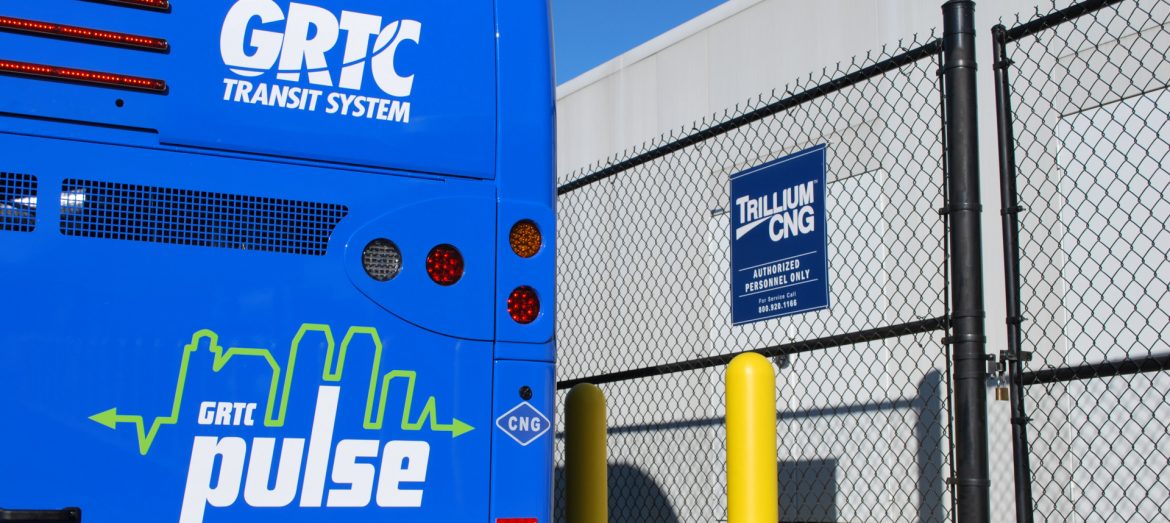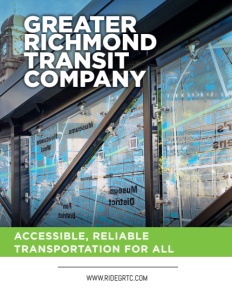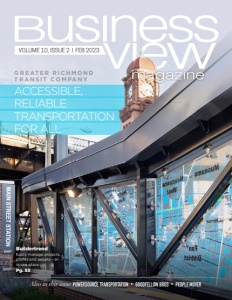Greater Richmond Transit Company
accessible, reliable transportation for all
With a host of passenger upgrades, route changes, and tech solutions, Greater Richmond Transit Company speeds ahead
Virginia’s Richmond region is home to one of the oldest continually operating public transit systems in the United States, with over 160 years of service. Since 1860 this long-standing transportation service has been a mainstay of the community, evolving over time from rail to streetcar to bus. Today, the Greater Richmond Transit Company (GRTC) continues to offer progressive options to its riders throughout the region, with ongoing service improvements and upgrades that make it one of North America’s most efficient transit systems.
“Our objective is to provide reliable, safe, and on-time transportation to our constituents,” shares CEO Sheryl Adams. She relays that GRTC will continue to offer zero-fare transportation in 2023 and 2024, something they have been doing since the start of the pandemic.
“This will allow people to not have to worry about providing fares to catch the bus, but they can use those funds for other things such as food, shelter or housing.”
This zero-fare initiative is due in part to Virginia’s Department of Rail and Public Transit (DRPT), which offered funding through a Transit Ridership Incentive Program (TRIP). Joe Dillard Jr., Equitable Innovation & Legislative Policy Director elaborates, “With the TRIP program, we were awarded a favorable circumstance with a local match requirement. What that meant was that if the DRPT was going to give us $4.5 million, a match from our local partners would be required to offset.”
“Eventually it will be a step-down. In year one, DRPT is providing 80%. In year four they are providing 0%., local partners have been very supportive, and GRTC will continue to work with them on the sustainability of zero fares”. he adds.
Evidence shows that the zero-fare program is a benefit in the region, where over 50% of riders make under $25,000 . “The accessibility and equity in the zero-fare program have shown value in improving quality of life. We are getting people around in a meaningful way. It is getting people from home to work. ” Dillard shared.
One thing that was highlighted for GRTC during the pandemic was the fact that in the Richmond region, transit is an essential service. With ridership dropping across the country as people moved to remote work, Adams acknowledges, “Here in the city of Richmond, our ridership only dropped around 20% of where it was pre-pandemic, but we are now back to our pre-pandemic numbers. Something that we definitely learned is that we still provide service to a lot of essential workers to get to and from work.”
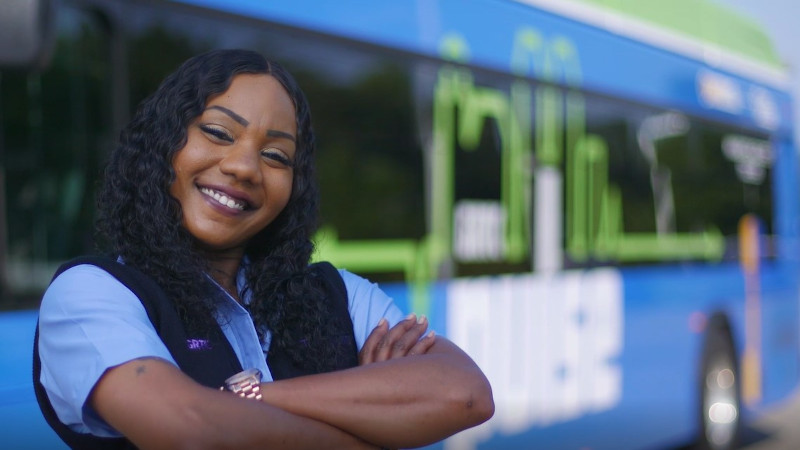
Regular collaboration with the transportation planning organizations of each jurisdiction ensures that Greater Richmond Transit Company understands the needs of the rider base in each community.
“Whenever we have any sort of changes within any of the routes, we’ll engage within the neighborhoods, to make sure we are actually reaching our riders. We’ll also take the next step of going on vehicles to provide information,” Chief Of Staff, Adrienne Torres conveys.
Growth and expansion are also planned through a partnership with regional liaisons, and engagement with the community. As for community outreach, she acknowledges, “Our last survey showed that 92% of our riders are utilizing our system to go from home to work. So that is our staple of us as an essential service. We haven’t done additional outreach, just to the workforce.As we go out to the community, we do reiterate the importance of transit to support the workforce and quality of life-related to that.”
Community engagement is also promoted with help from groups like local Chambers of Commerce, and RVA Rapid Transit, an independent body advocating for transit options in the region.
Currently serving the city of Richmond, as well as Henrico and Chesterfield County, GRTC will soon be implementing a micro-transit service to serve Ashland, Powhatan, New Kent, Chesterfield, and Henrico counties. Torres explains that this micro-transit will operate as an “on-demand” model, using smaller shared-use vehicles such as vans or shuttles, which can transport a few people at a time. “This will expand our current footprint, and also let us pilot a new mode. We are looking at doing a dual operating service, meaning that the micro-transit zones that are more rural will be a turnkey third party and then GRTC will operate the ones that are adjacent to our current footprint of fixed route service.” Torres stated.
Greater Richmond Transit Company is also planning to introduce a north-south BRT (Bus Rapid Transit) in the near future, as outlined in its annual regional public transportation plan. Phase 1 study is currently underway.
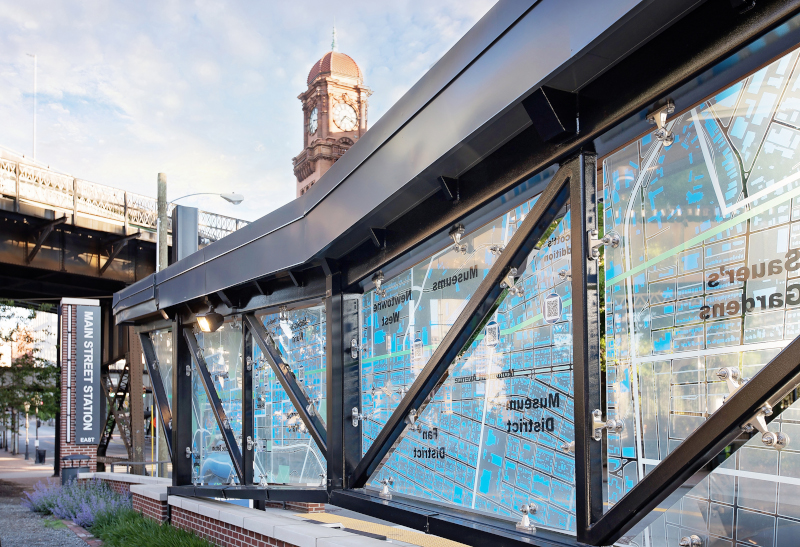
Continued investment into the vehicles themselves is also necessary, as John Zinzarella, Chief Financial and Administrative Officer remarks, “It’s capital intensive. We’re always refreshing our rolling stock as there are guidelines between age and mileage. We are also looking towards expansion, from the standpoint of people that we need to operate the buses, as well as what types of buses to accommodate the different types of modes that we want to introduce over the next 3 to 10 years.”
The implementation of an Enterprise Resource Plan (ERP) is also underway, along with other back office infrastructure which is needed to support expansion. “As we expand, we’re going to need, potentially, more office spaces as well as possibly more space to park and house vehicles,” adds Zinzarella.
Along with plans for expansion comes the need to recruit new bus operators while retaining current ones. Adams asserts, “They are the backbone because, without bus operators, we can’t provide a service.”
Represented by a union, all of GRTC’s operators and mechanics are under a collective bargaining agreement. During the pandemic, an effort was made to adjust compensation, to show appreciation for their continued work and exceptional job during the challenges of the time. This was done through a series of COVID Appreciation bonuses.
Incentives for new hires and additional training stipends for those in a training program have also been introduced, along with bonuses as they progress through the training. “We’ve also recognized that we wanted to incentivize the existing employees outside the terms of the contract for the hours they put in, and recognize the off shifts, the night shifts, and weekend shifts that have more work-life balance issues. So, we’ve done that,” Zinzarella reports.
“The employees feel that this is a familial environment. We would like to keep that legacy feeling, and we want to provide a workplace that they enjoy coming to, where they feel that they’re being recognized, and where they’re contributing, as well as feeling that they’re having compensation and benefits programs that are very competitive with other opportunities. It’s multipronged to try to do that.” Zinzarella .
Looking to the future, one of the questions Greater Richmond Transit Company is investigating is how to best power the fleet, especially as the US moves towards greener energy sources. At this point, Zinzarella says the majority of vehicles are powered by compressed natural gas, but they are constantly researching new technologies that could be more viable.
A study that will consider all of the alternative fuels available is also slated to begin, which Torres says will, “feed into what we plan on doing for future vehicle purchases.” A facility master plan will also be done, determining infrastructure improvements that would be needed to support an alternative fuel source.
As for what GRTC will focus on in 2023, Adams remarks, “What we would like to achieve is to ensure that we are providing reliable service to as many people as we possibly can. Our goal is to return to pre-pandemic service levels, and then to implement prioritized expansion as much as possible, depending on our manpower.
The benefits of this to the community are instrumental, as Dillard Jr. concludes, “GRTC is a community partner. For every dollar that is invested into a bus system, the return on economic development is about $4.”
AT A GLANCE
Greater Richmond Transit Company
What: A provider of BRT through the Richmond region
Where: Richmond, Virginia
Website: www.ridegrtc.com
